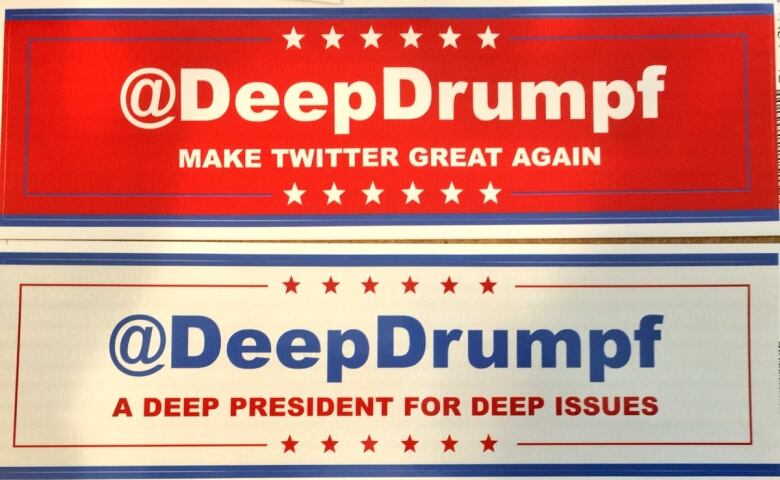Twitter bot creates 'remarkably Trump-like' tweets
DeepDrumpf parody account uses AI and Donald Trump's actual speeches, tweets to mimic his style

On social media, Donald Trump uses the handle @realDonaldTrump.But there are plenty of imitators and parody accounts, including a Twitter bot created by a scientist at MIT.
"DeepDrumpf"uses artificial intelligence to mimic the real Donald Trump's speech patterns creating what MIT says are"remarkably Trump-like statements."
CBC Radio technology columnist Dan Misenerdigs deep into DeepDrumpf.
What's the story of DeepDrumpf?
This is a parody Twitter account that started back in the spring.The name riffs on comedian John Oliver's call for Donald Trump to go back to his family's ancestral name, Drumpfand deep learning, which is a specialized field of computer science.
- John Oliver asks America to make Donald Drumpf again
- Deep Learning Godfather says machines learn like toddlers
Basically, it's is an algorithm designed to mimic Donald Trump's voice on Twitter.It works by taking a prompt the first few words of a sentence and then completingthat prompt basedon statistical probabilities.
So if yougave it the words "make America great," for example, it could complete that sentence with the word "again."
Oranother example tweeted during the most recent presidentialdebatewhen the algorithm was given the prompt "math is a...", itresponded with this:
[Math is a] common democrat lie. It can't make the budget great. I'll have the best economy. #debatenight
—@DeepDrumpfAnd while DeepDrumpf isa goofy example, the underlying technology here is powerful and it'spart of a growing field that's having a profound effect on many aspects of technology.
How is it able to mimic the real Donald Trump?

It can do this because it knows a lot about how the real Donald Trump speaks.
Brad Hayes isa post-doctoral associate at MIT's Computer Science and Artificial Intelligence Laboratory (CSAIL), and the creator ofDeepDrumpf. He says hecollected a large amount of original source material, and fed it into his algorithm to train it.
"So it's a giant text file that contains... many of his public rally speeches, debate transcriptsand the tweets that are actually his," he said.
He says it's also still learning.
"I thinkI'm currently at model number 34 or 35 as of today. It's retraining right nowas we speak."
Basically, the algorithm analyzed all this training data to figure out how Trump speaks in public.Then, when given a prompt, it creates its fulltweetbased solely on the statistical probabilities of what will follow, gleaned from past speeches.
How convincing is it?
If you're familiar with Donald Trump's tweeting style, DeepDrumpf's messages can seem uncanny.They seem to have the rhythm and cadence of the real Trump, and some of them could pass as legitimate Trump tweets.
For instance, this tweet:
[My plan for the GDP is] number one. Believe me. But ISIS wants to kill us over our trade deals. We have to strengthen our borders. #debate
—@DeepDrumpfAt first glance, that could be mistaken for a realTrump tweet.
But others seem slightly off.It's important to point out that the algorithm doesn't actually understand the meaningof language, only the statistical probability that certain words are likely to appear in a certain order. Sometimes you end up with something fairly nonsensical:
OK, it's amazing right now with ISIS, I tell you what? I don't want them to vote, the worst very social people. I love me.
—@DeepDrumpfBut part of why DeepDrumpf is sometimes successful at mimicking the real Donald Trump probably has to do with the nature of Twitter itself. Twitter is built for brevity, and individual tweets are often read out of context. If you're a bot trying to pass yourself off as human, Twitter's a pretty good place to do that.
What's the goal of this Twitter bot?
Hayes started all of this as an experiment, and a way to learn more about artificial intelligence.But a funny thing happened after he made DeepDrumpf publicit became fairly popular. With two weeks to go before the election, it has more than 26,000 followers on Twitter.
Hayes decided he should do something with all that attention. So he started a crowdfunding campaign, with all the proceeds going towards GirlsWho Code, anorganization dedicated to closing the gender gap in technology.

In a strange twist, this weird algorithmically-generated parody Twitter account is raising real dollars to address the technology gender gapwhich is a realissue in that industry.
- Study raises questions about gender bias in the world of coding
- Grassroots coding, gaming groups tackle tech's diversity crisis
What's next for these kind of AI mimics?
DeepDrumpf is just one example of using AI to create a a digital imposter, or mimic.Earlier this year, Google announced something called WaveNet, which is speech synthesis software. Basically, if you give it a samples of a person's voice, it can generate audio spoken words that convincingly mimic that person's voice.
In the visual realm, Hayes mentioned an algorithm called Neural Stylethat can mimic the visual style of any artist. You give it two images, and it can modify the first one so it's in the style of the second one. So your family photo can be painted in the style of Picasso or van Gogh, for example.
We're seeing more and more examples of computer software that tries to mimic human speech, writingor artistic creativity. These systems get better and better the more training data they have.
AndHayes said hissoftware could be used to mimic anyone. As the election campaign has gone on, his Twitter bot has gotten "Trumpier" for better or for worse.












_(720p).jpg)


 OFFICIAL HD MUSIC VIDEO.jpg)
.jpg)



























































































